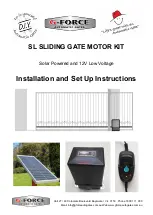
SAFETY
» IMPORTANT SAFETY INFORMATION
INSTALLATION
To prevent SERIOUS INJURY or DEATH from a moving gate:
• Pinch points must be guarded at all times. Install enclosed-style gate tracks and
roller guards.
• Place screen mesh 4 feet (1.2 m) high on the gate to prevent access through
openings anywhere the gate may travel.
• Mount controls at least 6 feet (1.8 m) from the gate or ANY moving part of the
gate.
• Install Warning signs on EACH side of gate in PLAIN VIEW. Permanently secure
each Warning sign in a suitable manner using fastening holes.
• This operator is intended for vehicular use only. To prevent INJURY to
pedestrians, a separate pedestrian access should be supplied, visible from the
gate. Locate the pedestrian access where there is not a chance of INJURY at any
point during full movement of the gate.
• Contact sensors MUST be located at the leading and trailing edges, and post
mounted both inside and outside a horizontal slide gate. Non-contact sensors
such as photoelectric sensors MUST be mounted across the gate opening and
operate during BOTH the open and close cycles.
• Entrapment protection devices MUST be installed to protect anyone who may
come near a moving gate.
• Locate entrapment protection devices to protect in BOTH the open and close
gate cycles.
• Locate entrapment protection devices to protect between moving gate and
RIGID objects, such as posts or walls.
• Too much force on gate will interfere with proper operation of safety reversal
system.
• NEVER increase force beyond minimum amount required to close gate.
• NEVER use force adjustments to compensate for a binding or sticking gate.
• If one control (force or travel limits) is adjusted, the other control may also
need adjustment.
• After ANY adjustments are made, the safety reversal system MUST be tested.
Gate MUST reverse on contact with a rigid object.
• DO NOT touch the heater when switch is on, heater may be hot.
• To AVOID damaging gas, power or other underground utility lines, contact
underground utility locating companies BEFORE digging more than
18 inches (46 cm) deep.
• To prevent damage to the operator or gate, DO NOT drive the limit actuators on
the shaft past their normal positions.
• ALWAYS wear protective gloves and eye protection when changing the battery
or working around the battery compartment.
To reduce the risk of SEVERE INJURY or DEATH:
• ANY maintenance to the operator or in the area near the operator MUST NOT
be performed until disconnecting the electrical power and locking-out the power
via the operator power switch. Upon completion of maintenance the area MUST
be cleared and secured, at that time the unit may be returned to service.
• Disconnect power at the fuse box BEFORE proceeding. Operator MUST be
properly grounded and connected in accordance with national and local
electrical codes.
NOTE:
The operator should be on a separate fused line of
adequate capacity.
• ALL electrical connections MUST be made by a qualified individual.
• DO NOT install ANY wiring or attempt to run the operator without consulting the
wiring diagram. We recommend that you install an optional reversing edge
BEFORE proceeding with the control station installation.
• ALL power wiring should be on a dedicated circuit and well protected. The
location of the power disconnect should be visible and clearly labeled.
• ALL power and control wiring MUST be run in separate conduit.
WIRING
To reduce the risk of SEVERE INJURY or DEATH:
• Without a properly installed safety reversal system, persons (particularly small
children) could be SERIOUSLY INJURED or KILLED by a moving gate.
• Too much force on gate will interfere with proper operation of safety reversal
system.
• NEVER increase force beyond minimum amount required to close gate.
• NEVER use force adjustments to compensate for a binding or sticking gate.
• If one control (force or travel limits) is adjusted, the other control may also
need adjustment.
• After ANY adjustments are made, the safety reversal system MUST be tested.
Gate MUST reverse on contact with a rigid object.
ADJUSTMENT
6








































